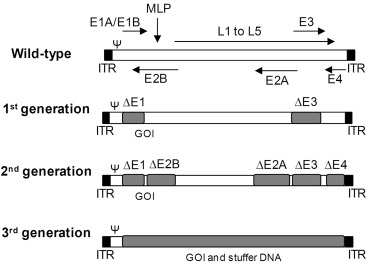 |
|
|
| Home -> Support -> Articles -> Brief Introduction of Recombinant Adenoviruses | ||
| Quick Inquiry |
Brief Introduction of Recombinant Adenoviruses Adenoviruses (ADV) are non-enveloped particles containing a linear double-stranded DNA of ~36 kb. Recombinant adenovirus (rADV) is engineered to contain gene of interest and have been considered as an attractive tool for gene delivery. ADV has several features that make it possible to be designed as a useful genetic transfer tool. 1) Like LV, ADV can transduce both dividing and non-dividing cells with almost 100% transduction efficiency. 2) Compared with lentivirus (LV) and Adeno-associated Virus (AAV), ADV can accommodate larger transgenes. 3) Optimized protocols have been developed for producing rADV at high titers. 4) The viral genome of ADV does not integrate into the host cells’ genome which means ADV can not cause random insertion mutation but also means it can not be used for long-term expression but for transient expression. There is a known drawback using ADV which is its strong immunogenicity that may lead to the death of transduced cells. Interestingly, scientists have also utilized this drawback to develop rADV vectors for applications in oncolysis and vaccination. rADVs can be divided into different subgroups according to the fiber protein, cloning capacity and replication ability. 1) Subgroups based on fiber protein 2) Subgroups based on cloning capacity  Figure 1. Schematic representation of wild-type adenovirus genome and the different generations of nonreplicating AdV. E1 to E4, early-region transcript units; L1 to L5, late region transcript unit; ITR, inverted terminal repeats; MLP, major late promoter; Ψ, packaging signal, GOI, gene of interest. [Adenoviral Vectors for Gene Therapy, David T. Curiel · 2016] 3) Subgroups based on replication ability Product List for Adenoviral Plasmids
For More Readings [1] 1. Luo, Jinyong, et al. "A protocol for rapid generation of recombinant adenoviruses using the AdEasy system." Nature protocols 2.5 (2007): 1236. PubMed PMID: 17546019.[2] X Danthinne, M J Imperiale. “Production of first generation adenovirus vectors: a review.” Gene Ther. 2000 Oct;7(20):1707-14. doi: 10.1038/sj.gt.3301301. PMID: 11083491 DOI: 10.1038/sj.gt.3301301 [3] T C He, S Zhou, L T da Costa, J Yu, K W Kinzler, B Vogelstein. “A simplified system for generating recombinant adenoviruses.” Proc Natl Acad Sci U S A. 1998 Mar 3;95(5):2509-14. doi: 10.1073/pnas.95.5.2509. PMID: 9482916 PMCID: PMC19394 DOI: 10.1073/pnas.95.5.2509 [4] E Dormond, M Perrier, A Kamen. “From the first to the third generation adenoviral vector: what parameters are governing the production yield?”. Biotechnol Adv. Mar-Apr 2009;27(2):133-44. doi: 10.1016/j.biotechadv.2008.10.003. PMID: 19013226 [5] Cristian Capasso, Mariangela Garofalo, Mari Hirvinen, Vincenzo Cerullo. “The evolution of adenoviral vectors through genetic and chemical surface modifications”. Viruses. 2014 Feb 17;6(2):832-55. doi: 10.3390/v6020832. PMID: 24549268 PMCID: PMC3939484 |
|
|
Products & Services Resources | ||
|
Home Products & Services Support About Us Contact Us |
Promotions Flyers Brochures Publications News & Events |
Terms & Conditions Privacy Disclaimers |
Contact Us EMAIL: admin@rgbiotech.com |
||
| © RGBiotech All Rights Reserved. | |||||
